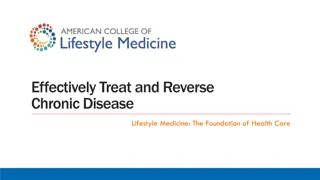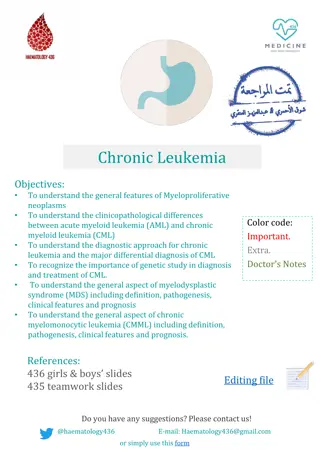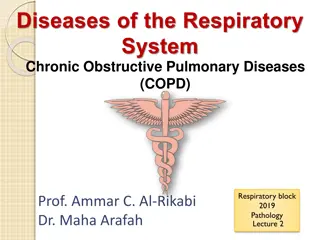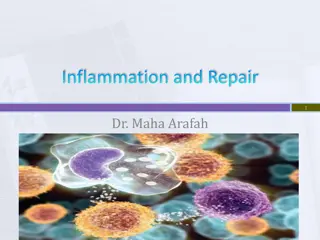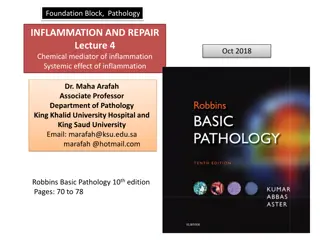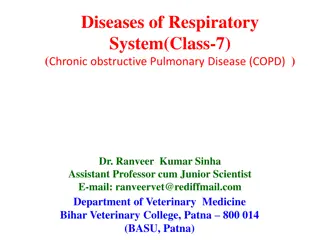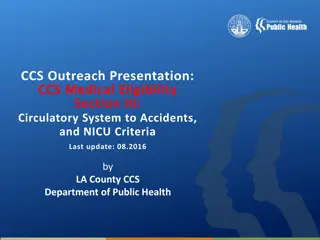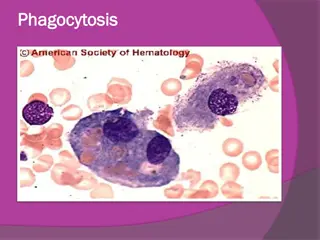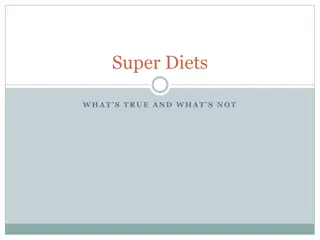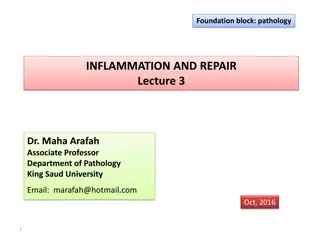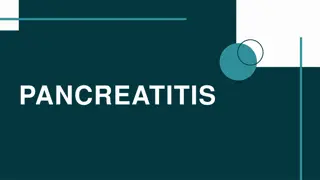Understanding the Link Between Diet, Inflammation, and Chronic Diseases
Inflammation is the body's natural response to injury, infection, or attack, but chronic low-grade inflammation can lead to various diseases. The immune system plays a crucial role in protecting the body against harmful substances. Chronic diseases like obesity, diabetes, and cancer often have underlying inflammatory processes. Research is ongoing to explore the connections between diet, inflammation, and disease prevention.
Download Presentation

Please find below an Image/Link to download the presentation.
The content on the website is provided AS IS for your information and personal use only. It may not be sold, licensed, or shared on other websites without obtaining consent from the author. Download presentation by click this link. If you encounter any issues during the download, it is possible that the publisher has removed the file from their server.
E N D
Presentation Transcript
Inflammation Inflammation is a set of symptoms that include pain, swelling, heat, and redness of an affected organ or tissue It is the natural way the body s immune system responds to injury, infection or attack There has been increased discussion regarding another form of inflammation that is not aligned with pain and is referred to as chronic low-grade inflammation or silent inflammation The links between diet, inflammatory processes, and diseases are the topics of intense current research
Immune System The immune system is the body natural defense mechanism The immune system protects the body against foreign substances (antigens) bacteria, viruses, toxins, food proteins that cause allergies, etc. If the immune system fails, the body becomes vulnerable to disease
Immune System Tissues Mucus membranes Lymphoid tissue Lymphatic vessels Cells Defense proteins Leukocytes Phagocytes Neutrophils Macrophages Lymphocytes Natural killer cells B-cells T-cells Physical barriers: body s first line of defense against foreign substances: Skin Mucous membranes Gastrointestinal tract Organs Thymus gland (make T cells) Bone marrow (make B cells) Spleen Tonsils Adenoids Lymph nodes Gastrointestinal tract
Acute and Chronic Inflammation Acute inflammation - beneficial Immune system responses to infection or injuring resulting in inflammation, fighting infection or injury, and then stops Immune system responses and get recovery Chronic inflammation harmful Low grade inflammation that persists Chronically inflamed tissues produce bioactive compounds that sustain the inflammatory response Low grade inflammation can suppress immune response If constantly turned on at a low level the immune system get used to it and is not responsive (flies under the radar) Immune system responds but no recovery
Chronic Diseases and Inflammation Many diseases, especially chronic diseases, reflect an underlying inflammatory process such as: Obesity Metabolic syndrome Atherosclerosis Type 2 diabetes Hypertension Certain types of cancer Rheumatoid arthritis Others
Obesity and Inflammation Chronic inflammation accompanies obesity Adipose (fat) tissue is metabolically active and produces compounds that promote inflammation As adipose tissue fills up, fat migrates to other tissues -muscles and liver (ectopic fat) The combination of increased ectopic fat and inflammation disrupts normal glucose and lipid metabolism leading to: Insulin resistance Elevated blood lipids (also promotes inflammation) High blood pressure (also promotes inflammation) This cluster of symptoms is known as metabolic syndrome which increases the risk for type 2 diabetes, atherosclerosis, and cardiovascular disease (heart disease and hypertension).
Atherosclerosis and Inflammation Atherosclerosis initiated by minor but chronic damage to the blood vessel wall Blood vessel damage increases permeability of the blood vessel wall and initiates an inflammatory response. The immune system responds by sending in macrophages. LDL cholesterol becomes trapped inside the blood vessel wall. Free radicals produced during inflammatory response oxidize LDL cholesterol. Macrophages take up the oxidized LDL cholesterol. Swell up with oxidized LDL cholesterol and eventually become plaque. Blood vessel damage and inflammation also favor formation of blood clots As damage progresses, inflammatory response intensifies Plaque instability and weakens the blood vessel wall
Challenge is to Maintain Beneficial Effects of Inflammation Yet Limit Harmful Consequences The fact that many diseases reflect an underlying inflammatory process yet inflammation is critical to immune system response presents a challenge to identify factors that will both protect the beneficial effects and limit the harmful consequences
Diet and Inflammation Research suggests that certain dietary components may modulate key inflammatory pathways Research is still currently being conducted investigating the effects of dietary components on inflammation
Diet and Inflammation Possible pro-inflammatory dietary factors Excess calories Saturated and trans fats Highly processed foods Highly processed meats Highly refined carbohydrates
Diet and Inflammation Possible anti-inflammatory dietary factors: found in fruits, vegetables, whole grains, lean protein foods (lean meat, poultry, pork and fish; beans, peas and lentils; nuts and seeds), low-fat or fat-free dairy, and healthy fats) Healthy fats Omega-3 fatty acids Monounsaturated fats Vitamins and minerals (vitamin C, E, selenium, magnesium, zinc) Fiber Phytonutrients Polyphenols Carotenoids Probiotics and prebiotics
Diet and Inflammation However, at the present lime, the research to support specific dietary recommendations regarding inflammation is lacking More research is needed What foods/food components How much How often
Diet and Inflammation Currently, the best advice is to adopt a healthy dietary pattern including a variety of nutritious foods Make fruits and vegetables half your plate Choose a variety of brightly colored fruits and vegetables Make half your grains whole grains Vary your protein routine Choose lean protein foods Include fish; beans, peas and lentils; nuts and seeds Move to low-fat or fat-free milk or yogurt Choose healthy fats Choose those high in omega 3 and monounsaturated fats Limit foods and beverages higher in added sugars, saturated and trans fat, and sodium
Diet and Immune System Health A healthy dietary pattern also provides the nutrients needed to support a healthy immune system Calories Vitamin A Protein Vitamin C Omega 3 fatty acids Vitamin E Vitamin D Vitamin B6 Vitamin B12 Folate Zinc Selenium Iron Magnesium Copper Prebiotics Probiotics
Other Lifestyle Factors and Inflammation Regular physical activity Adequate sleep Manage stress
Questions? Thank You for Coming! Oklahoma State University, as an equal opportunity employer, complies with all applicable federal and state laws regarding non-discrimination and affirmative action. Oklahoma State University is committed to a policy of equal opportunity for all individuals and does not discriminate based on race, religion, age, sex, color, national origin, marital status, sexual orientation, gender identity/expression, disability, or veteran status with regard to employment, educational programs and activities, and/or admissions. For more information, visit https:///eeo.okstate.edu 2021 Oklahoma Cooperative Extension Service 17


![READ [PDF] Dash diet Cookbook for beginners: 365 days of simple, healthy, low-s](/thumb/2057/read-pdf-dash-diet-cookbook-for-beginners-365-days-of-simple-healthy-low-s.jpg)


